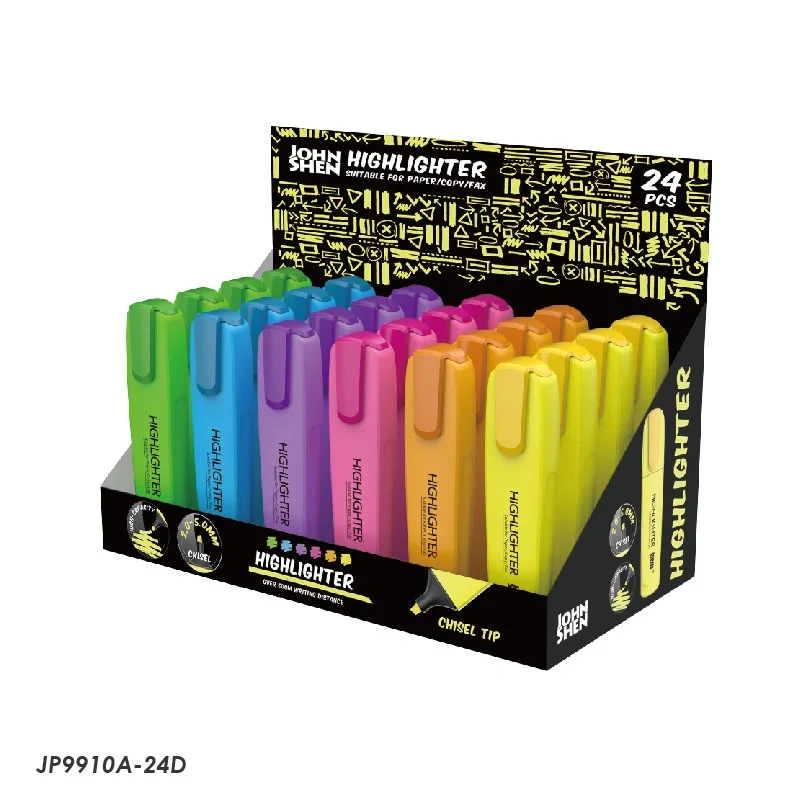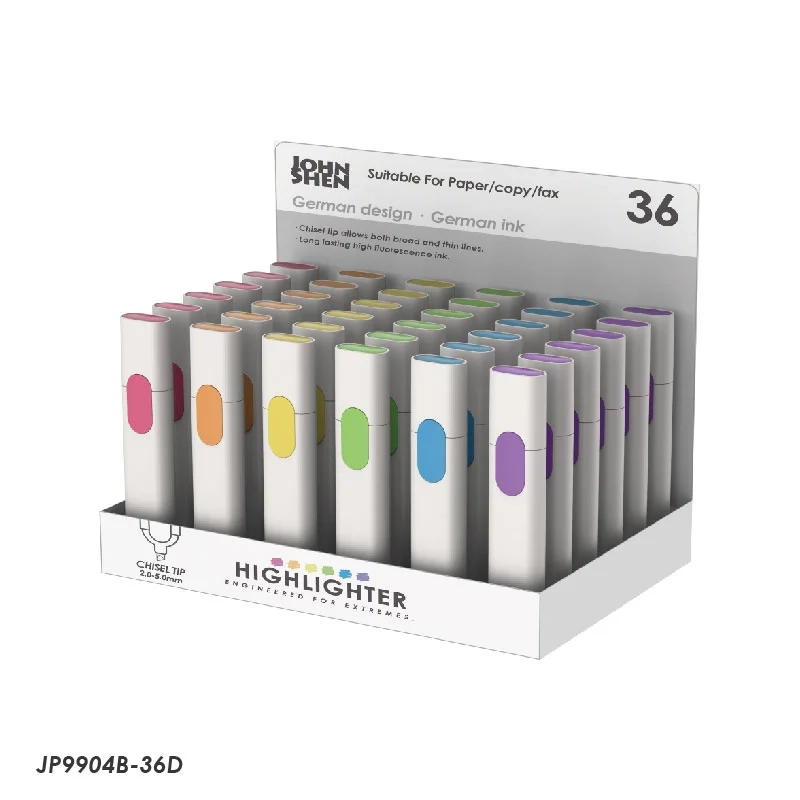- This topic is empty.
-
AuthorPosts
-
2024-02-26 at 1:46 pm #22448
Liquid highlighter is a common office stationery that is also widely used for studying and note-taking. They often come in bright colors and can make eye-catching marks on books, notebooks, and documents. The ink of these highlighters is water-based and usually contains fluorescent pigments and some chemical additives. When used, the tip of the highlighter glides easily over the paper without leaving a heavy ink mark on the paper. This makes them a popular markup tool for students and professionals alike.
The development history of liquid highlighter:
Liquid highlighters date back to the 1960s, and the original liquid highlighters used bromide phosphors, which emit bright colors without staining the paper. This new marking tool quickly gained wide popularity and became one of the commonly used stationery items for students and office workers.
Over time, the design and formulation of liquid highlighters have improved, making them more convenient and effective for writing and marking. The continuously innovative ink formula and pen head design have made it widely used in all walks of life, becoming one of the indispensable tools in modern office and learning.
The main ingredients of liquid highlighters usually include the following:
Fluorescent pigment: This is the most important component of liquid highlighter, which determines the color and fluorescent effect of the highlighter. Fluorescent pigments are usually composed of fluorescent substances and fluorescent substrates.
Solvent: The solvent of liquid highlighter is usually water or alcohol, which is used to dilute the fluorescent pigment so that the highlighter ink can be released smoothly from the pen tip.
Preservatives: To extend the life of liquid highlighters, preservatives are often added to the ink to prevent the growth of bacteria and mold.
Gelling agent: This ingredient is used to control the viscosity and fluidity of the ink, ensuring that the highlighter works smoothly when writing and marking.
Other additives: Some liquid highlighters may also contain other additives, such as color enhancers, anti-fade agents, etc., to enhance the fluorescent effect and extend the life of the highlighter.
Classification of liquid highlighters:
Ordinary liquid highlighters: They have bright fluorescent colors and are suitable for general writing and marking. They are usually available in a variety of colors, such as yellow, green, pink, etc., and can be marked in different colors as needed.
Double-ended liquid highlighter: A double-ended liquid highlighter is equipped with two different pen tips on the pen body, usually a thin tip and a wide tip. The fine tip can be used for detailed marking and writing, while the wide tip is suitable for large areas of application and high-gloss marking. The double-head design makes it more flexible and versatile to meet different writing needs.
Erasable Liquid Highlighter: Erasable liquid highlighter is a special type of highlighter whose ink has erasable properties. Text or patterns marked with an erasable liquid highlighter can be erased with an eraser or special eraser, making modifications and corrections easy. This type of highlighter is often used in study and office settings, and is especially suitable for situations that require frequent modifications and adjustments.
High-brightness liquid highlighter: High-brightness liquid highlighter has a stronger fluorescent effect and higher brightness, capable of producing more eye-catching marks on paper.

Features and benefits of liquid highlighter:
Liquid highlighters have many advantages over traditional solid highlighters. First of all, the ink of liquid highlighter is fuller, the color is more vivid, and it is not easy to fade. Secondly, the pen tip is softer, writing smoother, and less likely to damage the paper. Additionally, liquid highlighter ink dries faster, resists smudging, and is more convenient to use.
Liquid highlighter uses and application areas:
Learning and Education: Liquid highlighters are a common marking tool used by students and teachers to highlight key points in teaching materials.
Office & Business: Use to mark and highlight key information in meetings, presentations and reports.
Document processing: can be used to mark, annotate, and organize files to improve work efficiency.
Arts & Crafts: The vibrant colors of liquid highlighters make them a creative tool in painting and crafting.
Tips for using liquid highlighter:
When using liquid highlighter, knowing a few tips can help you get the most out of it and improve your markings. Here are some usage tips:
Gentle Marking: When using the liquid highlighter, you don't need to use too much force, just a gentle stroke. Excessive force may cause the ink to penetrate the lower layers of the paper, causing blurring and smudging.
Avoid repeated smearing: When marking text, try to avoid repeatedly smearing the same place. This will cause too much ink and affect the reading experience.
Avoid long dwell times: When using a liquid highlighter on paper, don't leave the tip in the same position for too long to avoid excessive ink penetration.
Avoid using on copies: Liquid highlighter inks often create a blurry effect when copied, so it's best to use a pencil or light-colored water-based pen on documents that need to be copied.
Don't use it on important documents: Liquid highlighters are bright in color, but also difficult to erase, so it's best to mark important documents with a pencil first and make sure they are correct before using.
Note on storage: Liquid highlighters must be capped after use to prevent the ink from evaporating or drying out. In addition, avoid high temperatures and direct sunlight to avoid affecting the quality of the ink.
It should be noted that liquid highlighter is a chemical product and you should pay attention to safety when using it. Avoid direct contact with skin and eyes and avoid ingestion.

Care and maintenance of liquid highlighter:
Proper care and maintenance can extend the life of your liquid highlighter and ensure the effectiveness of your writing and marking. Here are some maintenance methods:
After using the liquid highlighter, cover the pen cap in time to prevent the ink from evaporating or drying up.
Storage method: It should be stored in a cool and ventilated place, away from high temperature and direct sunlight, so as not to affect the quality of the ink.
Clean the pen tip: If the pen tip is clogged, you can gently rinse it with water or wipe it with a paper towel, but avoid using excessive force to cause the pen tip to deform.
Avoid over-squeezing: When using, avoid over-squeezing or using too much force to avoid ink spillage or damage to the nib.
As a practical stationery item, liquid highlighter can not only improve study and work efficiency but also add fun to artistic creation. Of course, you also need to pay attention to some details when using it to ensure that its advantages can be fully utilized. With the continuous advancement of technology, I believe that liquid highlighters will have a broader space for development in the future, bringing more convenience and fun to people's lives.
Three advantages of mini highlighter, so you can't put it down.
How to choose the mini highlighter that suits you?
How to choose a mini highlighter supplier
Explore the colorful world of highlighters
Color matching tips for highlighters: Make your notes more vivid and colorful
Environmental issues and solutions for highlighters
-
AuthorPosts
- You must be logged in to reply to this topic.